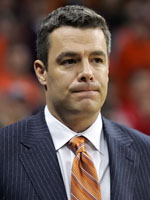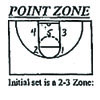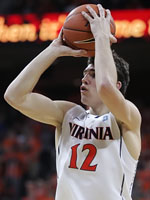 |
|
Tony Bennett |
A season after a convincing 68-48 victory over George Mason in the friendly confines of the John Paul Jones Arena, the Virginia Cavaliers travel up U.S. 29 to open the 2012-2013 season against Paul Hewitt’s squad at the Patriot Center. Will the Hoos notch another victory against their northern Virginian neighbors, or will Hewitt record his first win against Tony Bennett? Find out in the George Mason Primer.
1. Hewitt vs. Bennett. In Tony Bennett’s first year in the ACC, UVa registered 1 of its 5 ACC wins (82-75) against a Hewitt-helmed Georgia Tech team that would go on to make the 2nd round of the NCAA Tournament. In Bennett’s second year, the Hoos beat the Yellow Jackets both at home (72-64) and on the road (62-56), greasing the wheels on Hewitt’s firing. After Jim Larranaga left Fairfax for Coral Gables, the Patriots scooped up Hewitt, who led the team to a solid 24-9 (14-4 CAA) record last season. One of those losses came at the JPJ against the Cavs.
2. Defense. Hewitt’s 0-5 record against Bennett is no mistake, and it all starts on the defensive side of the ball. Hewitt teams typically run a 3-2 point zone defense. This defense actually starts as a 2-3 look with the “1” and “3” on the left side (because most players are right handed) and the “2” and “4” on the right side.

Then, when the ball leaves the “chute area” (the area immediately behind the paint as if the lines were extended) the defense shifts into a 3-2 zone, with one defender always on the ball (point) and one player always defending the basket (hole). The “5” is always between the ball and the basket. When the “2” is on the ball (point), the “3” is under the basket (hole). When the “1” is on the ball (point), the “4” is under the basket (hole).
You can see how this switching can create matchup or rotation problems for Mason, and the Hoos could be able to exploit that with the versatility of their players. That versatility includes a few more options from behind the arc than last year when the Cavaliers hit on 7 of 14 3-balls against the Patriots. That success last year can be explained by the troubles that a screen-heavy offense creates for Hewitt’s point zone defense. In the point zone defense, the on-the-ball defender stays with the dribbler until the screen is set and then “passes off” the person with the ball to the next defender to become the point (the on-the-ball defender).

By the end of the season, this passing off can be done with precision. During the first game of the season, it is susceptible to break downs, especially when you have cohesion issues in the line-up (more on this later).
Learn more about the defense in this pdf.
3. Offense. On the offensive end, Hewitt’s teams typically run a “4-out, 1-in” motion offense. As the name indicates, this offense typically initiates with 4 players equally spaced outside the 3-point line, with one post player moving as the ball moves. Take a look at it here.
I won’t dwell on this “41” motion offense too much in this Primer except to say that its goal is to pull the defense out of the paint, which explains why it hasn’t been terribly effective against Tony Bennett and the stay-at-home Pack-Line defense. I’m not going to dwell on this offense too much because Hewitt intimated after Mason’s 76-72 exhibition victory over D-II Bowie State that the Patriots might run more of a traditional two-guard, two-forward, one-center offense this year. Then again, with Mason’s suspensions and injuries, who knows?
4. Starting Lineup. First, let’s start with George Mason players from last season who won’t see the floor against the Hoos. The Patriots’ starting frontcourt last season consisted of leading scorer Ryan Pearson (17 points per game) and second-leading scorer Mike Morrison (9.8 PPG), both of whom have graduated. Erik Copes, who started for Mason at center in its exhibition game against Bowie State, is suspended for the first three games of the season, and the same goes for Vaughn Gray, who I had penciled in as their starter at the “3.” Also gone is point guard Andre Cornelius, who started 17 games last year for the Patriots after being suspended at the start of the season (including for the UVa game).
 |
Point Guard: I will call junior Bryon Allen (No. 0) the presumptive starter at the point, but he’s been suffering from a strain of the mid-trapezius (a muscle in the neck/shoulder area) and could be out or limited against us. Allen is 6’3″ and 214 pounds and plays more of a physical than a speed game. Given that UVa might be starting Joe Harris at point guard, this match-up isn’t as bad as one might have expected. Most favorably for the Hoos, Allen’s not much of an outside threat, hitting on a mere 16.7% of his 3-pointers last season. On the other hand, he’s a pretty good distributor (3.7 assists per game), and, unsurprisingly given his size, a good rebounder for his position (3.1 rebounds a game).
Shooting Guard: Before Gray’s suspension, I would have picked Sherrod Wright as the starter at the “2,” but now I’m guessing that he’s shifted to the “3,” with Vertrail Vaughns (No. 11) getting the nod at shooting guard. Vaughns is a 6’2″, 184-pound junior and is faster than Allen, which could cause some problems for Paul Jesperson should the two be matched up. He’s the team’s second-leading returning scorer after averaging 8.8 points per game last year and took the most 3-point attempts of any Patriot last year (118), connecting on 35.6% of them.
Small Forward: With Gray at the “2,” I expect Sherrod Wright (No. 10) to shift over to the “3.” Wright is a 6’4″, 196-pound junior who was suspended for the exhibition against Bowie State for doing “something not very intelligent this summer.” Gray is a dangerous but inconsistent offensive weapon who is equally adept at slashing and shooting. He is the Patriots’ leading returning scorer with 9.6 points per game last season, and he really picked it up at the end of the year, scoring 10+ points and shooting 57.1% or better from the field in 7 of the team’s last 8 games. He also led the CAA last year in hitting free throws at an 85.9% clip.
Power Forward: The starting “4” for the Patriots likely will be Jonathan Arledge (No. 5), a 6’9″, 228-pound junior. Arledge has a solid inside-outside game but is known more for his defensive prowess than his offensive acumen. While his numbers improved throughout last year, he shot a mere 40% from the field and averaged 4.3 points and 3.1 rebounds per game in 12 minutes per game.
Center: At the “5,” expect to see Johnny Williams (No. 2), a 6’8″, 240-pound redshirt junior who was out last year with a shoulder injury. The report from the exhibition against Bowie State was that Williams is still a bit rusty, coughing the ball up 5 times, although he did flash a pretty mid-range jumper. Before his injury, Williams was good for about 2.5 points per game in just less than 10 minutes per game in his first two seasons.
5. Significant Backups. George Mason’s depth looks like this.
Point Guard: If Allen is out or limited, expect to see significant minutes for Corey Edwards (No. 13), a 5’11”, 177-pound sophomore at the “1.” In my opinion, this would be a good thing for the Hoos, especially if walk-on Doug Browman sees some minutes at the point. Allen was quite limited offensively as a freshman, averaging 2.5 points per game on 33.8% shooting (including 26.5% from behind the arc) in 15.2 minutes per game. He also had as many turnovers as assists per game (2.2).
Small Forward: Marko Gujanicic (No. 14) is a 6’8″, 226-pound sophomore from Serbia by way of California. I kind of see him as Mason’s version of Evan Nolte and would like to see these two young guys with a lot of basketball savvy matched up on the hardwood. The big guy averaged about 17 points, 9 rebounds, and 6 assists per game while shooting 58% from the floor and 40% from 3-point range in his senior year of high school.
Power Forward: I haven’t seen a minute of him playing, but Anali Okoloji (No. 14) is a 6’8″, 232-pound redshirt sophomore who transferred from Seton Hall. He averaged about 2 points per game in 3 minutes per game in his freshman campaign for the Pirates, and your guess is as good as mine as to how he performs after a year practicing in Hewitt’s system. My understanding is that he is supposed to be fairly athletic.
6. Prediction. Given the fluctuations in lineup for both teams, I’m not going to predict a score for this one, but I do predict a UVa win in a relatively close and sloppy game. With Mason’s issues at the point guard position, I don’t think that Virginia is at as big of a disadvantage without Jontel Evans as it might be against other teams. Meanwhile, Mason’s lineup turnover and suspensions at the 3, 4, and 5 positions, should give UVa an advantage on the boards and limit the Patriots’ second chance opportunities.
Note: Throughout the season, No Fear Cavalier will provide primers for some of the Cavaliers’ key opponents.



